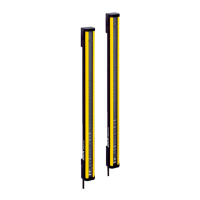4.3.4.1 Using reversed direction of transmission
Using reversed direction of transmission
T
he direction of transmission of the system 2 can be changed during installation by
switching the positions of the sender and receiver. With reversed direction of transmis‐
sion, the receiver 2 is not affected by the infrared light from the sender 1.
Figure 12: Trouble-free operation due to reversed direction of transmission of system
1
and sys‐
tem
2
4.4 Integration in electrical control
Overview
T
his chapter contains important information about integration in the electrical control.
Information about the individual steps for electrical installation of the device: see "Elec‐
trical installation", page 41.
Requirements for use
The output signals of the protective device must be analyzed by downstream controllers
in such a way that the dangerous state of the machine is ended safely. Depending on
the safety concept, the signal is analyzed by, e.g., safety relays or a safety controller.
DANGER
H
azard due to lack of effectiveness of the protective device
In the case of non-compliance, it is possible that the dangerous state of the machine
may not be stopped or not stopped in a timely manner.
b
Make sure that the following control and electrical requirements are met so that
the safety light curtain can fulfill its protective function.
•
It mus
t be possible to electrically influence the control of the machine.
•
The electrical control of the machine must meet the requirements of IEC 60204-1.
•
A restart interlock must be implemented depending on applicable national regula‐
tions or required reliability of the safety function. Because the safety light curtain
does not have this function, it must be implemented in the external control if
required.
•
When using a safety controller, different signal levels of both OSSDs must be
detected depending on applicable national regulations or required reliability of the
safety function. The maximum discrepancy time tolerated by the control must be
selected according to the application.
•
The OSSD1 and OSSD2 output signals must not be connected to each other.
•
In the machine controller, the signals of both OSSDs must be processed sepa‐
rately.
PROJECT PLANNING 4
8014253/ZOH3/2017-08-04 | SICK O P E R A T I N G I N S T R U C T I O N S | deTec4 Core
23
Subject to change without notice

